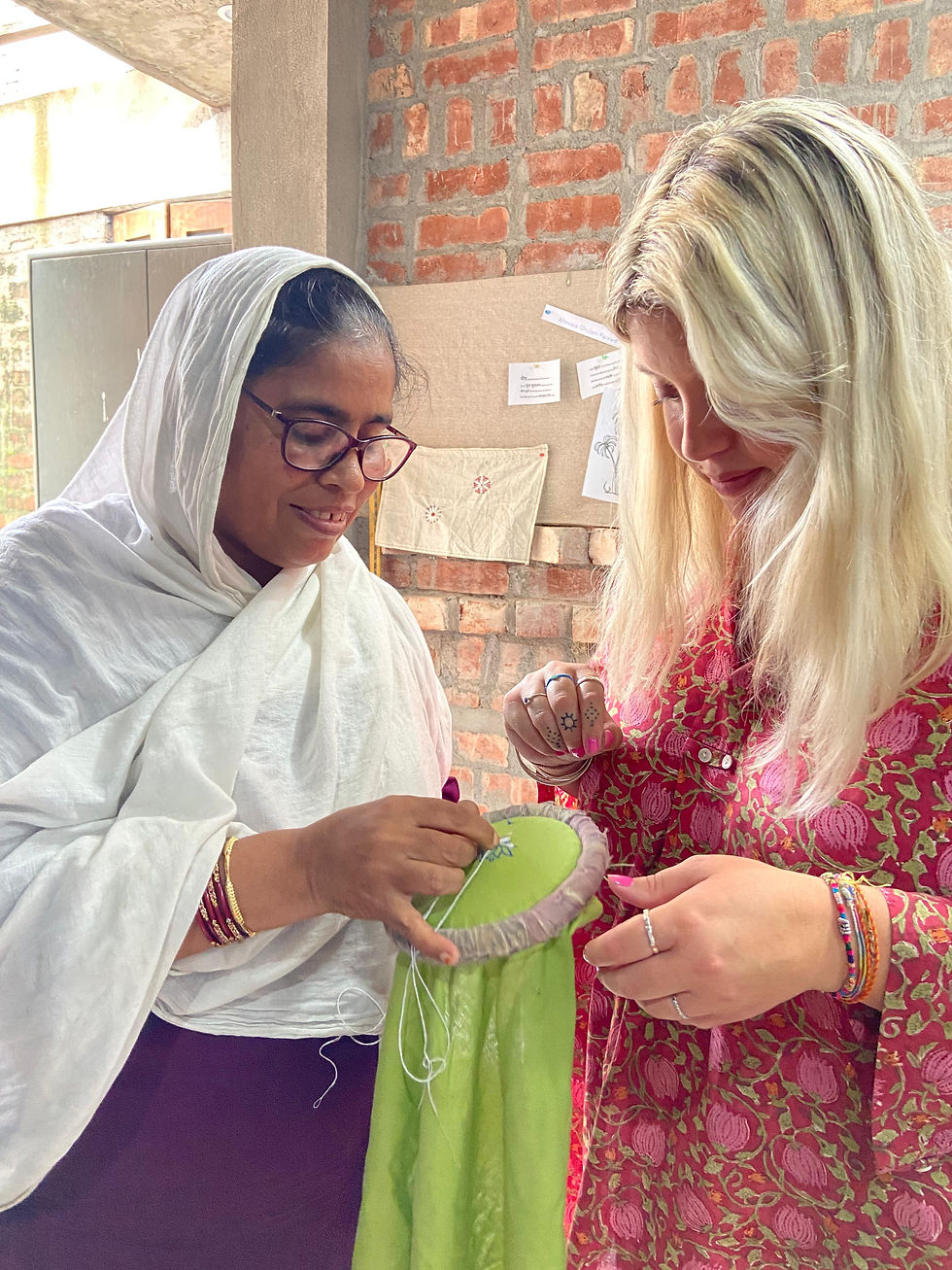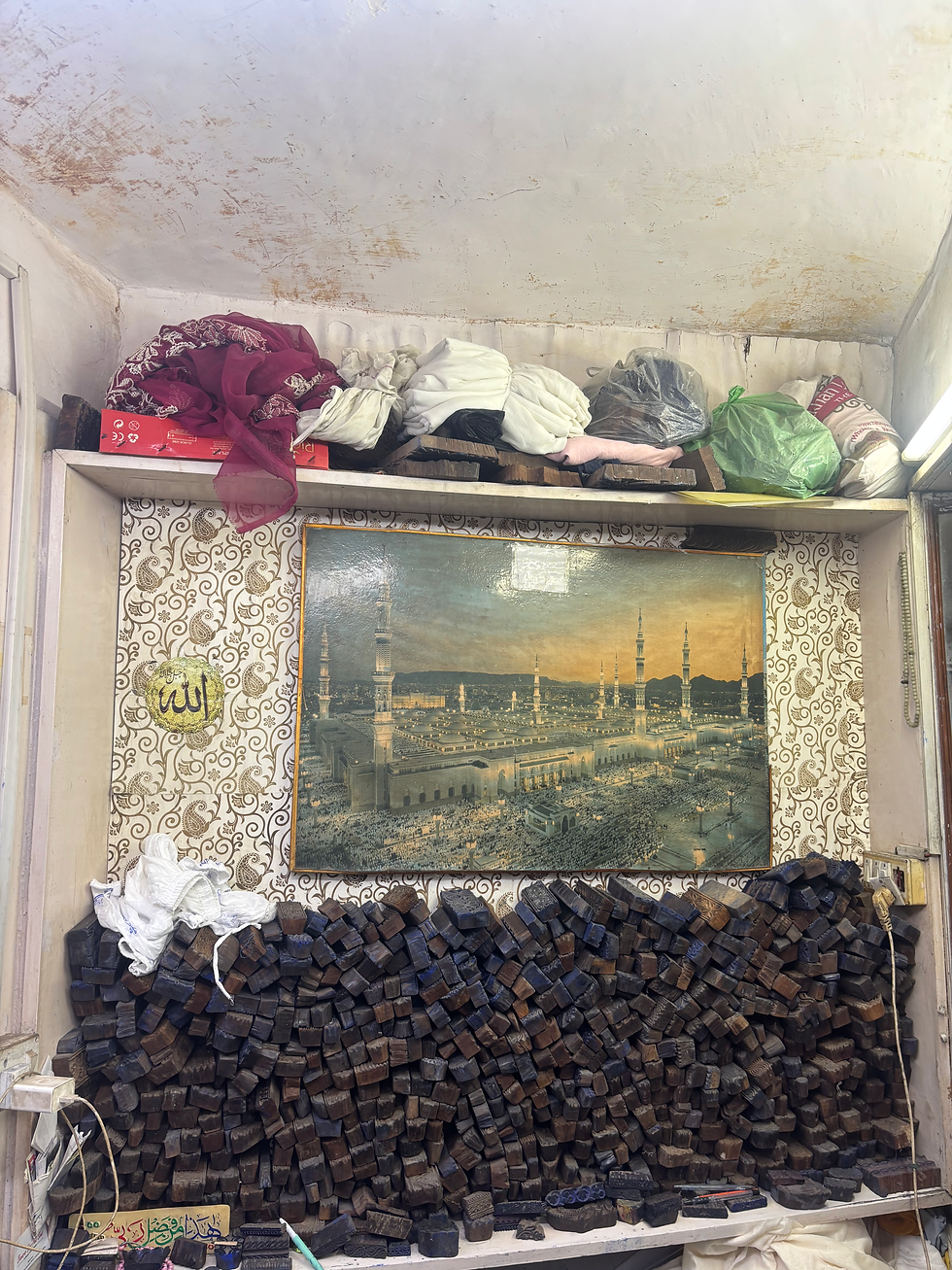Chikan embroidery in contemporary Lucknow
- Sian Warren

- Sep 7
- 4 min read
Updated: 17 hours ago
It always surprises me that a city as exciting and historic as Lucknow so often slips off the radar for travellers exploring India - especially those heading north. Yet Lucknow has so much to offer: achingly beautiful architecture, thriving artisan and craft traditions, a mouthwatering food scene, and some of the most polite and welcoming people you could hope to meet. To give this special place the attention it deserves, I want to look at one of it's most famous textiles - Chikankari.
This isn’t a history lesson in the strict sense, but rather a journey into how the legacy of Chikan embroidery lingers in Lucknow today. Once celebrated by the Nawabs, who in the 18th and 19th centuries elevated this delicate hand embroidery into a symbol of refinement and royal luxury, Chikankari became inseparable from the city’s cultural identity. Their courts nurtured the craft, their patronage ensuring it flourished in both skill and status. But the Nawabs have long since vanished, leaving behind only echoes of their world.
However, the embroidery remains, its image still entwined with Lucknow’s past - but what, in the midst of modern life, is the story it tells now?

Today's story of Chikankari
Traditionally made by talented muslim artisans, it is the simplicity that captivates the eye: fine, intricate stitches worked by hand, most often in white thread on soft white cotton, a whisper of pattern and texture rather than a loud display of colour. Its name, chikan, carries mysteries of its own, with history tracing it variously to the Persian chakeen, a coin said to have paid the artisans, or to chiq, the latticed screens that once shielded women in purdah. The word 'Kari', also Persian, means 'work' (chikan-work). You will find clothing and tablelinen all across the city with this work, in patterns of trailing stems, petals and flower heads.
For a time, Lucknow’s famed chikankari seemed destined to fade into history. With the decline of royal patronage and the dismantling of the karkhanas - the old workshop systems that had once nurtured the craft - its future grew uncertain. The arrival of cheaper, mass-produced fabrics only deepened the crisis. What had once been a symbol of grace and leisure now struggled to survive in a world moving too quickly to pause for hand-stitched beauty.

But the 1980s brought a turning point, led not by kings or nobles but by the women themselves. In narrow lanes across Lucknow, chikankari became more than embroidery; it became a lifeline. SEWA - the Self-Employed Women’s Association - emerged out of a 1979 study by UNICEF and Literacy House that had exposed the harsh reality: women and children in the chikan industry were among the most exploited in Uttar Pradesh’s unorganised sector. Middlemen controlled the craft and its profits, leaving the artisans with barely enough to survive.
SEWA set out to change that story. By connecting the women directly to markets and dismantling the old system of dependence, they ensured fair wages and steady work. Over time, earnings grew, dignity returned, and with it, chikankari began to reclaim its place - not just as craft, but as livelihood, identity, and quiet resilience. SEWA are still operational today, and despite the challenges brought about by the covid-19 pandemic, they have weathered the storm and are still providing support and livelihood to hundreds of women in Lucknow and the surrounding villages.
On my last visit to Lucknow, I found myself climbing the worn steps of SEWA’s building - a structure that bore the weight of years, its peeling walls but alive with purpose. Inside, the air hummed with quiet industry. Women sat cross-legged on the floor, hands moving swiftly through fabric with needle and thread, others bent over wooden blocks or sifted through piles of paperwork. At the heart of it all was Ms. Runa Banerjee, SEWA’s CEO, whose presence filled the room without effort. She has spent decades steering this organisation through setbacks and successes, her dedication stitched as deeply into its story as the embroidery the women create. Around her, there was a sense of both struggle and strength, the crumbling walls and celling spoke of challenges yet to be overcome, but the women themselves carried a quiet pride, a solidarity born from shared work and shared purpose.

I also met with other pioneering organisations in Lucknow who are carving out their own relationship with chikan embroidery. One of them is Rafec, a 50-year-old institution dedicated to preserving the cultural heritage of Lucknowi Chikankari while building sustainable livelihoods for the women who keep the craft alive. Officially registered as an NGO in 1995, Rafec now works with over two thousand women across the region, championing ethical fashion and inclusive growth in an industry where tradition and modern opportunity must learn to coexist.
Then there’s Sangraha, a dynamic organisation blending heritage with social enterprise. Their model focuses on training women in embroidery skills, ensuring they have stable incomes and freeing them from the grip of middlemen who for too long paid unfairly and late. Sangraha has built its own brand of clothing and homeware rooted in sustainability while also taking on international commissions for contemporary embroidery. It’s a reminder that tradition doesn’t have to stay frozen in time - in the right hands, it can adapt, evolve, and thrive on a global stage.

Wandering through Lucknow’s lanes in search of chikan embroidery, I quickly learned that the craft now tells its own story. Most of the fabric comes from mills - cotton, polyester, rayon, and the occasional silk - each material shaping the look and feel of the final piece once the embroidery is complete. The quality of the stitches varies just as widely. Some pieces carry the patience of skilled hands, the quiet elegance of time-honoured tradition, while others speak to the pressures of modern demand and economy, hurriedly finished to fill the need for affordable garments in bazaars across India.
And perhaps that is where the true story lies - not only in the fabric or the stitches but in what they reveal about the changing story of the city itself. Chikan is no longer just the embroidery of Nawabs and royal courts; it has slipped into the everyday lives of Lucknow, where heritage and modernity walk side by side.




Further references:
Chikan Embroidery: the floral whitework of India - by Sheila Payne
Chikankari: A Lucknawi Tradition by Paola Manfredi


Comments